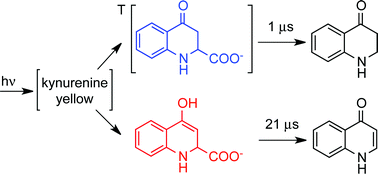The human eye is photoprotected by molecular UV filters which consist of low-molecular weight compounds in the lens that absorb UV light in the 300-400 nm spectral region. The UV filters decompose to give a mixture of products, which can include kynurenine yellow (KNY) and kynurenic acid (KNA) from the UV filter kynurenine. These compounds have only been found in very small or negligible concentrations in the human lens which may indicate that they are much more chemically or photochemically active than the original UV filters.

Read this article for free until the 8th February 2013:
Photochemistry of aqueous solutions of kynurenic acid and kynurenine yellow, Ekaterina A. Zelentsova, Peter S. Sherin, Olga A. Snytnikova, Robert Kaptein, Eric Vauthey and Yuri P. Tsentalovich, Photochem. Photobiol. Sci., 2013, DOI: 10.1039/C2PP25357G
Keep up to date with the latest developments from Photochemical & Photobiological Sciences by signing up for free table of contents alerts.










